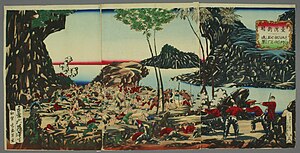
Back Expedició japonesa a Taiwan (1874) Catalan Japanische Strafexpedition nach Taiwan 1874 German Expedición japonesa a Taiwán (1874) Spanish تهاجم ژاپن به تایوان (۱۸۷۴) Persian Expédition de Taïwan de 1874 French Tajvan japán megszállása (1874) Hungarian Invasi Taiwan oleh Jepang (1874) ID Invasione giapponese di Taiwan (1874) Italian 台湾出兵 Japanese 모란사 사건 Korean
| Taiwan Expedition of 1874 | |||||||||
|---|---|---|---|---|---|---|---|---|---|
| Part of the Formosa Conflict | |||||||||
 Commander-in-chief Saigo (sitting at the center) pictured with leaders of the Seqalu tribe.  The Assault at Sekimon (石門進撃), May 22, 1874. | |||||||||
| |||||||||
| Belligerents | |||||||||
|
| Botan | ||||||||
| Commanders and leaders | |||||||||
|
| Unknown (DOW) | ||||||||
| Strength | |||||||||
|
Land: 3,600 Sea: 6 warships | Unknown | ||||||||
| Casualties and losses | |||||||||
|
12 killed ~30 wounded 561 died from disease[3] |
89 killed Many wounded | ||||||||
| |||||||||
The Japanese punitive expedition to Taiwan in 1874, referred to in Japan as the Taiwan Expedition (Japanese: 台湾出兵, Hepburn: Taiwan Shuppei) and in Taiwan and Mainland China as the Mudan incident (Chinese: 牡丹社事件), was a punitive expedition launched by the Japanese ostensibly in retaliation for the murder of 54 Ryukyuan sailors by Paiwan aborigines near the southwestern tip of Taiwan in December 1871. In May 1874, the Imperial Japanese Army and Imperial Japanese Navy attacked the indigenous Taiwanese peoples in southern Taiwan and retreated in December after the Qing dynasty agreed to pay an indemnity of 500,000 taels, with Japan conceding that China had sovereignty over Taiwan. Some ambiguous wording in the agreed terms were later argued by Japan to be confirmation of Chinese renunciation of suzerainty over the Ryukyu Islands, paving the way for de facto Japanese incorporation of the Ryukyu in 1879.
- ^ "WASHINGTON.; OFFICIAL DISPATCHES ON THE FORMOSA DIFFICULTY. PARTIAL OCCUPATION OF THE ISLAND BY JAPANESE THE ATTITUDE OF CHINA UNCERTAIN CHARACTER OF THE FORMOSAN BARBARIANS. THE RAILROAD AND THE MAILS. THE VACANT INSPECTOR GENERALSHIP OF STEAMBOATS. THE TREATY OF WASHINGTON. THE CURRENCY BANKS AUTHORIZED CIRCULATION WITHDRAWN. POSTMASTERS APPOINTED. APPOINTMENT OF AN INDIAN COMMISSIONER. THE WRECK OF THE SCOTLAND, NEW-YORK HARBOR. NAVAL ORDERS. TOLL ON VESSELS ENGAGED IN FOREIGN COMMERCE. THE TREASURY SECRET SERVICE. TREASURY BALANCES". New York Times. Washington. August 18, 1874.
- ^ Eskildsen, Robert (2010). "An Army as Good and Efficient as Any in the World: James Wasson and Japan's 1874 Expedition to Taiwan" (PDF). Asian Cultural Studies (36): 52–56.
- ^ アジア歴史資料センター, A03030094100, 正院修史局ヘ征台ノ節出兵総数死傷人員其外問合ニ付回答(国立公文書館)「JACAR(アジア歴史資料センター)Ref.A03030094100、単行書・処蕃書類追録九(国立公文書館)」。
- ^ Cunningham p. 7